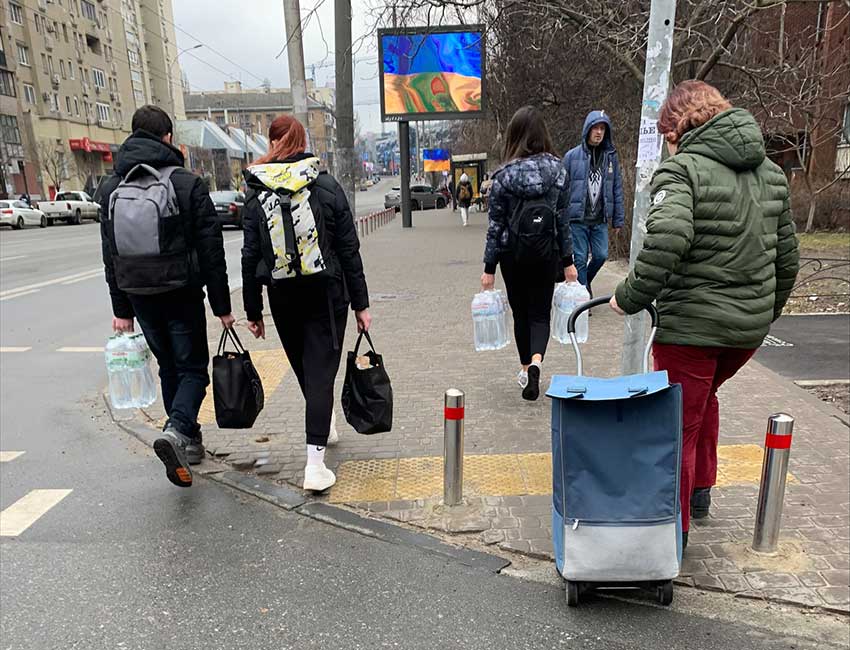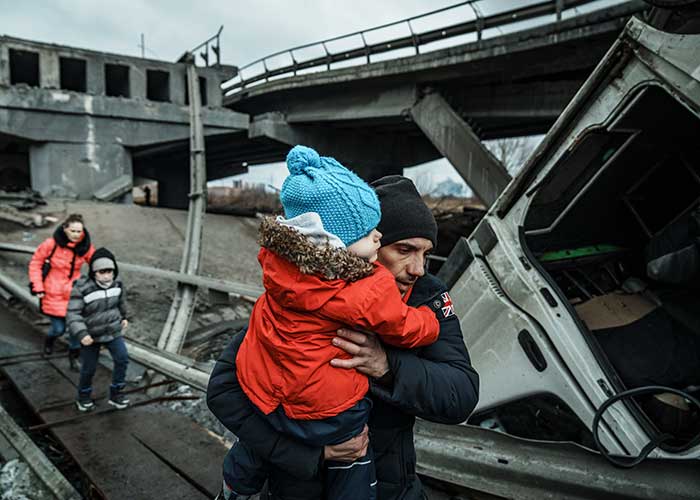Living in Kyiv is like living in London. It’s a beautiful, lively city and there’s always something happening. Life in Kyiv was wonderful – I can’t believe I’m saying “was”. Nobody expected this to happen. Up until the very last minute, people were getting on with their daily lives.
The morning after the first airstrike
The night before the first airstrike was just like any other night. My family and I went to bed expecting to wake up at our usual time and have breakfast together.
We woke up sometime around 4am to the sound of explosions. They were close enough to shake the house and loud enough to immediately get us out of bed with one thought in our minds: the war has started.
We knew we had to get underground fast. we had been advised to have emergency bags packed, but we didn’t believe it would happen. The basement was the only safe space to run to.
I knew in the coming days my family would need supplies, so I headed out at 9am to get extra food and water. I walked all the way to city centre because there were no Ubers, taxis or public transport. Within a few hours of the first attack, food had started to run out and there was already no bread on the shelves. The city that morning was not the busy Kyiv I knew. Large military trucks were already whizzing past on the empty streets where there would be traffic on any other weekday.
There were queues everywhere – outside petrol stations, supermarkets, banks, and even pharmacies – as people knew they had to stockpile.
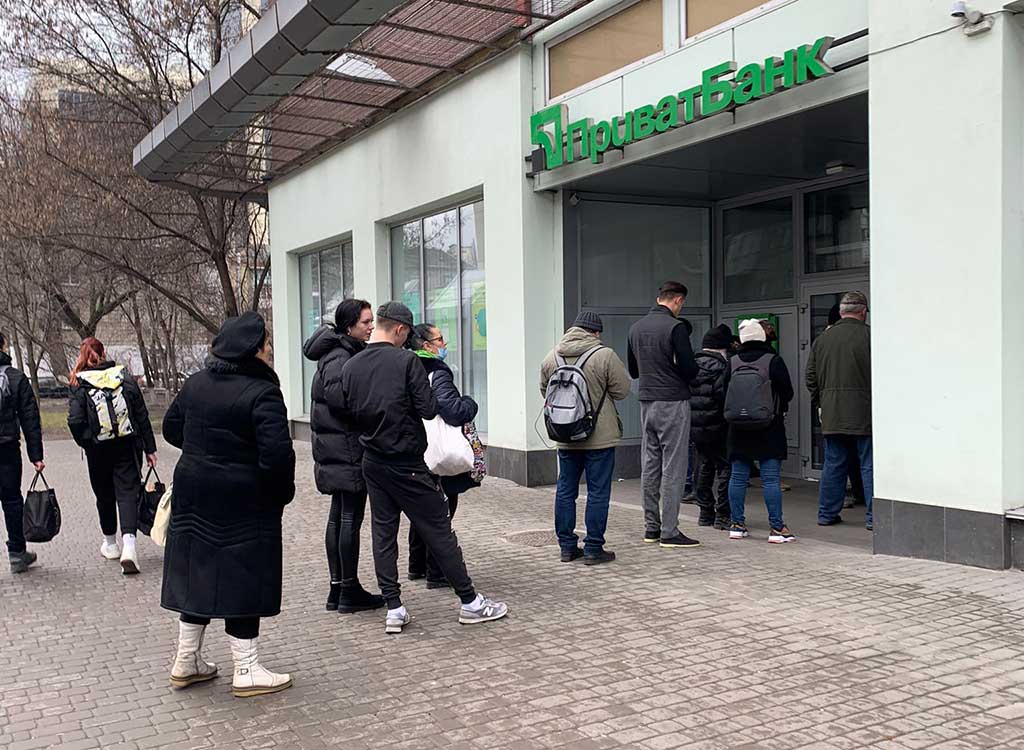
Queues at banks while people try to withdraw cash on the morning after the first airstrike.
Life underground
In the first few days, the main concern became who had underground shelters and who didn’t.
The population was so unprepared. No one knew where the underground bunkers were so everyone headed to metro stations.
There was a pattern to the explosions – it all started at around 4am. On the second day I counted 30 missiles before I stopped counting. We realised we had to get to a proper shelter. Our house is a home – not a bomb shelter – so the roof would collapse if it was hit.
When we got to the shelter it was so crowded. People had been camping from the night before and everyone had their own food and water in their own personal spaces. Everyone was really quiet and really scared. You could hear kids crying and saying they needed the bathroom but mums saying no because there are no toilets underground. People were too scared to go outside.
Food stores running out of supplies
From day one of the conflict, the entire country moved underground. My friends still in Ukraine say that they haven’t had any new supplies coming in for over ten days. Things have run out and some shops have just closed.
Because it’s so cold in Ukraine, they’re often very good at pickling and jarring food – so some people are now only living off jarred fruits and vegetables. The old ladies of Ukraine – the babushkas – are the professionals at this!
In southern areas of the country, people haven’t had enough food or drinking water for days. Some people are drinking melted snow to avoid dehydration – it’s a disaster.
In Kyiv, there’s still drinking water and electricity but in the south there’s nothing. Zero.
Anyone who had the money to leave left in the early days. Many doctors also left. Now even those who can’t afford to go to another country have no option but to leave.
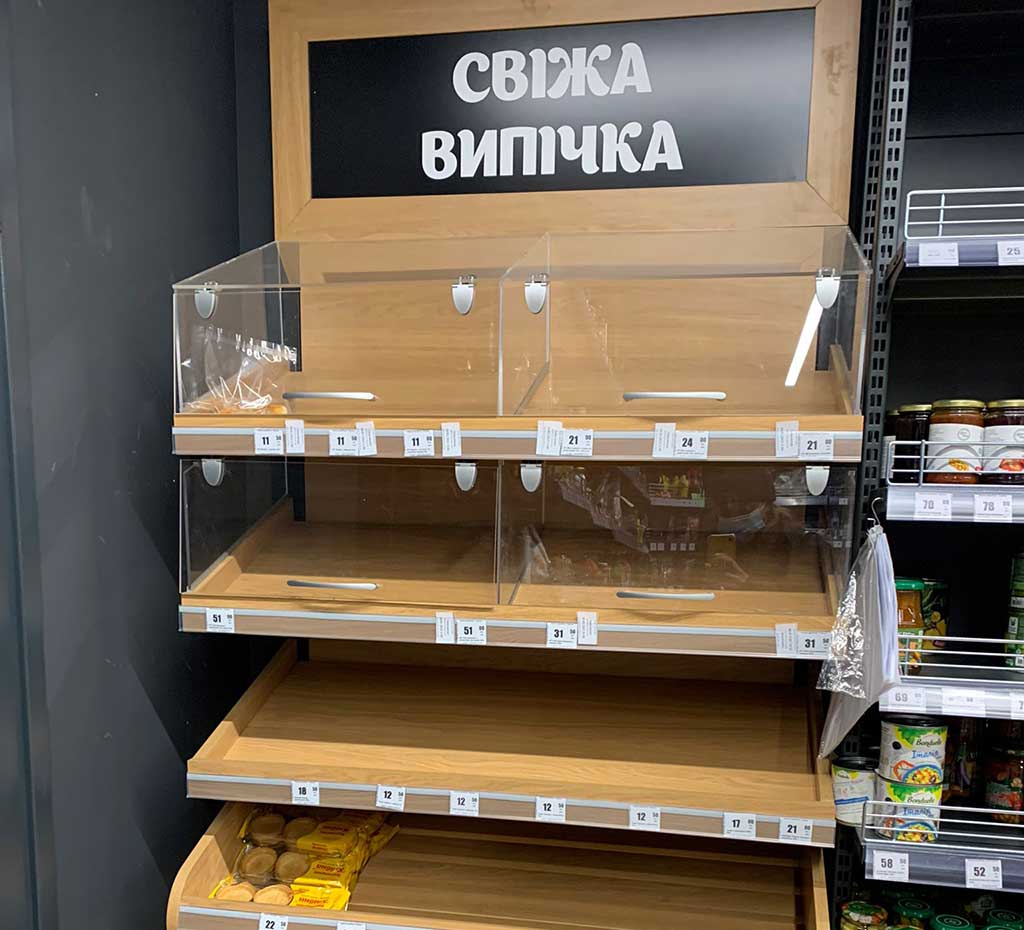
Empty bread shelves in Kyiv just hours after the first airstrike.
Escaping Kyiv
Seven days after the start of the conflict, I was able to leave Kyiv in a UN convoy. This was a privilege but also a risk. There was an official convoy of 20 UN cars with around 90 more cars unofficially following behind.
There was a lot of fear on that day. We knew evacuation routes were not being respected and anything could happen at any time. In the medical briefing the night before we left, the doctor gave explicit instructions on what to do in the case of broken bones, excessive bleeding and hard impacts. All week, everyone I was sharing the shelter with had more or less kept their composure, even through the daily airstrikes. But I could feel how nervous everyone was while watching the doctor demonstrate how to properly position an unconscious person.
The journey from Kyiv to Chisinau usually takes eight hours, but it took us 19 hours as we kept getting intel about incoming troops on our route. Even though we had UN flags and a police escort, there was no real guarantee of safety. But thankfully, because of the security measures everyone was able to leave the city without any issues.
There were almost 70 checkpoints in total. Some even had volunteers handing out food and water even though people didn’t have much to give. At almost every checkpoint there were roughly 100–300 cars lined up. We crossed easily but some civilians had to spend hours at each checkpoint.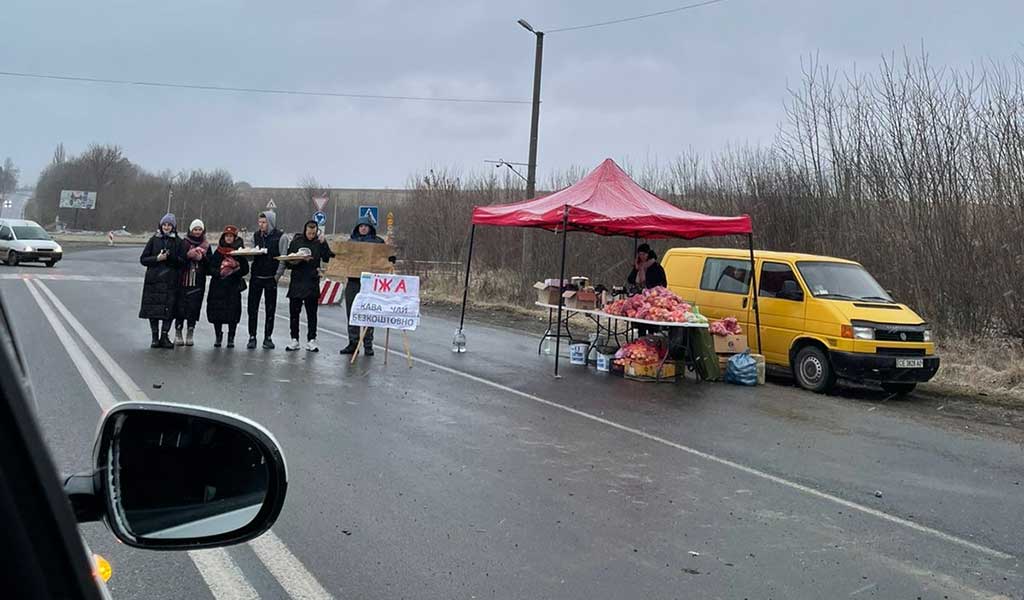
Food being handed out at a checkpoint in Ukraine. The sign says “Tea, coffee, free of charge.”
On the sides of the roads, we saw villagers digging trenches so that if a Russian convoy passed they could take cover and use their guns to fire at them.
At one point we stopped for a toilet break. In the mechanics garage near the petrol station, we saw women making Molotov cocktails. Shortly after at the nearby checkpoint, the air raid sirens went off and everyone had to rush back to cars to leave quickly.
Twenty minutes later we heard the sound of shelling and later found out that the area had been attacked. It was terrifying knowing that a place where we had just been was shelled.
The response in Moldova
Since arriving in Moldova’s capital Chisinau, I have been volunteering at the city’s two main refugee centres.
Every day thousands of refugees are arriving, but about half this number are also leaving Moldova – so it’s a big transit centre at the moment. It’s mostly poorer people who are staying at these refugee centres, as they can’t afford hotels or Airbnbs.
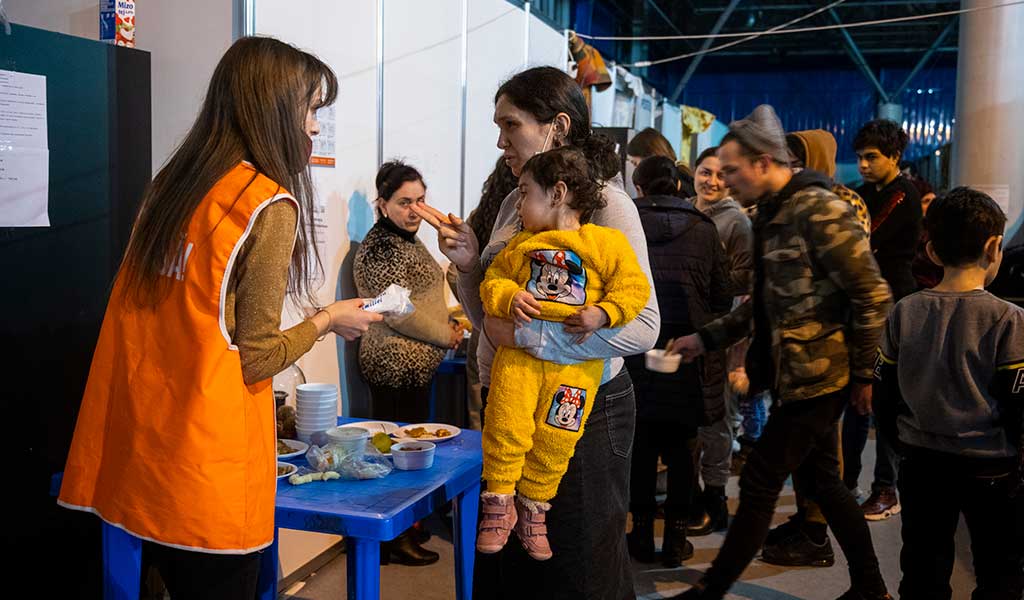
A woman asks for help at the Moldexpo exhibition centre, currently being used to shelter Ukrainian refugees. Photo credit: Action Against Hunger/ Gonzalo Höhr.
One centre – the Moldexpo exhibition centre – used to be a Covid centre. There are 500 beds, places to distribute food and even places for people to keep their pets. I am so impressed by how they’ve adapted the centre and how they’re organising the influx.
The other main centre is a sports centre with 700 beds. It’s a big arena with foldable beds and some mattresses on the ground.
They have psychiatrists working in the centres to help children with their trauma. They also have buses going to 44 other centres made up of schools, music halls – anywhere with heating. The only criteria for being a shelter at the moment is having a roof and heating.
For most people coming in, cash is the most useful form of support as the Ukrainian currency – the hryvnia – has depreciated and is worth almost nothing. There are plenty of food and hygiene supplies here in Moldova for people to buy. Ukrainians are a very proud population and it would help their dignity to be able to buy what they need themselves.
It’s also a timebomb for Covid breakouts with the influx of people, but it’s the least of their worries. Many children are arriving with diarrhoea mainly because they’ve only been able to eat high sugar, processed food as it’s the only type of food available. Hygiene is also difficult to maintain in the underground stations and crowded trains they have recently been in.
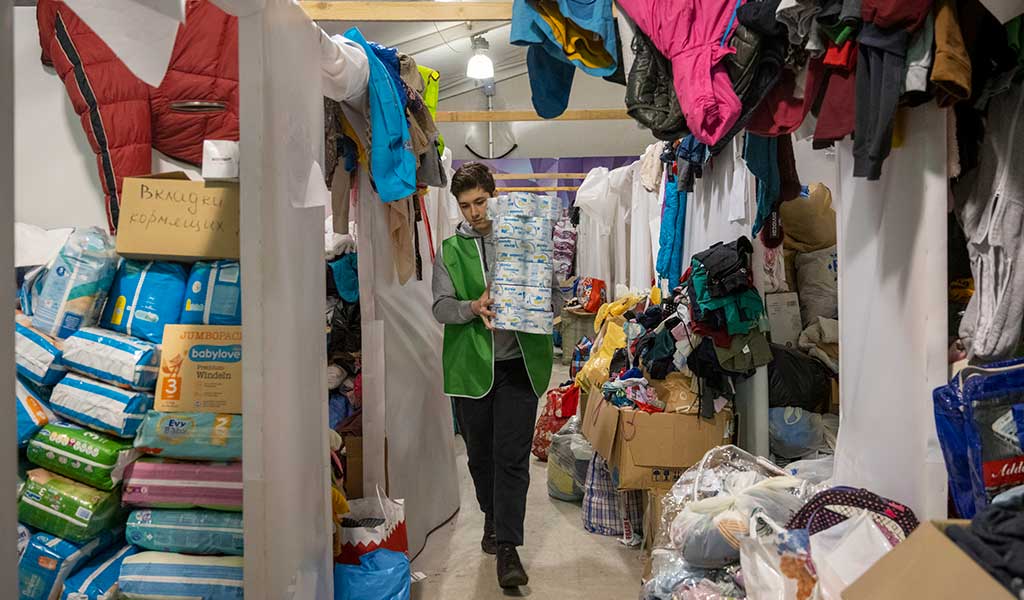
A volunteer with supplies at the Moldexpo exhibition centre, currently being used to shelter Ukrainian refugees. Photo credit: Action Against Hunger/ Gonzalo Höhr.
What happens next
This is truly one of those things I thought could never happen to me. Now I have a refugee visa on my passport, only a backpack of my belongings and no idea when or if I will be able to go back. Every single Ukrainian right now is feeling this pain tenfold.
Despite being displaced myself, as someone who is in the position to help, my first instinct has been to respond to the crisis in any and every way I can. I plan to continue my work here in Moldova and also travel to Romania and Hungary in the coming weeks. Depending on the situation in Ukraine, my priority would be to go back and help provide food and water to the most vulnerable groups. Every day, more and more refugees are fleeing to neighbouring countries. I want to help meet at least their basic needs after suffering such dire circumstances.

